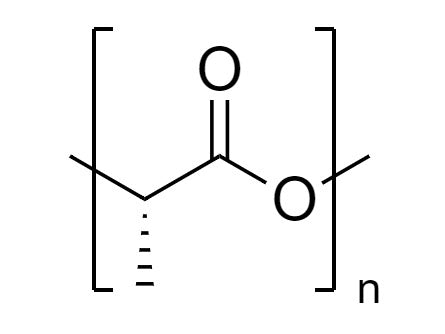
Polysciences Inc. Poly(L-Lactide), IV 1.0 dL/g, Ester Terminated, Powder
SKU: 50318-5
Polysciences Inc. Poly(L-Lactide), IV 1.0 dL/g, Ester Terminated, Powder
MSE Supplies offers polymer reagents from Polysciences Inc.
Product Overview
High-grade, suitable for biomedical research.
Supplied as micronized powder.
Poly(L-lactide) (PLLA) is a bioresorbable and biodegradable polymer that is highly sought after in the biomedical industry due to its excellent biocompatibility and mechanical properties. It is widely used in the production of medical devices such as sutures, bone plates, tissue scaffolds, and drug delivery systems. PLA is also seeing increased use in tissue engineering applications due to its ability to support cell growth and promote tissue regeneration.
PLA is frequently leveraged in the biomedical industry due to its well-researched biodegradation mechanisms, with the primary biodegradation pathway being via hydrolysis of its ester linkages. The biodegradation rate can vary based on factors such as the specific application, molecular weight, thickness of the final material, pH, the degree of exposure to enzymes, along with other biological factors.
Polysciences offers many PLA/PDLA homopolymer and copolymer products with varying molecular weights that will suit your research needs.
PLLA
Poly(L-Lactic acid)
L-Lactide polymer
Polylactide
Properties
Technical Specifications
| Test | Specification |
| Appearance | White powder |
| Identity by 1H-NMR | Conforms to structure |
| Inherent Viscosity (Chloroform) | 0.90 – 1.20 dL/g |
| Residual Monomer | ≤ 0.5 % |
| Residual Solvent | DMSO: ≤ 0.5 % |
| Residual Solvent | Isopropanol: ≤ 0.5 % |
| Residual Tin | ≤ 50 ppm |
| Water Content | ≤ 0.5 % |
| Residue on ignition | ≤ 0.1 % |
| Total Aerobic Microbial Count | ≤ 100 CFU/g |
| Total Yeasts / Molds Count | ≤ 100 CFU/g |
| Bacterial Endotoxin | ≤ 0.1 EU/mg |
References
1. Martino, C., Kim, S.-H., Horsfall, L., Abbaspourrad, A., Rosser, S. J., Cooper, J., & Weitz, D. A. (2012). Protein Expression, Aggregation, and Triggered Release from Polymersomes as Artificial Cell-like Structures. Angewandte Chemie, 124(26), 6522–6526. doi:10.1002/ange.201201443
2.Middleton, J. C. & Tipton, A. J. Synthetic biodegradable polymers as orthopedic devices. Biomaterials 21, 2335–2346 (2000). doi:10.1016/S0142-9612(00)00101-0
3. Lee, Kuan-Hsuan, Hsiu-Feng Huang, and Chieh-Tsung Lo. "Influence of precursor solvent and confined environment on the polymorphic transition in electrospun Poly (L-lactide) fibers." Polymer 237 (2021): 124339. https://doi.org/10.1016/j.polymer.2021.124339
4. Bonaccorso, A., et al. "Nose to brain delivery in rats: Effect of surface charge of rhodamine B labeled nanocarriers on brain subregion localization." Colloids and Surfaces B: Biointerfaces 154 (2017): 297-306. https://doi.org/10.1016/j.polymer.2021.124339
